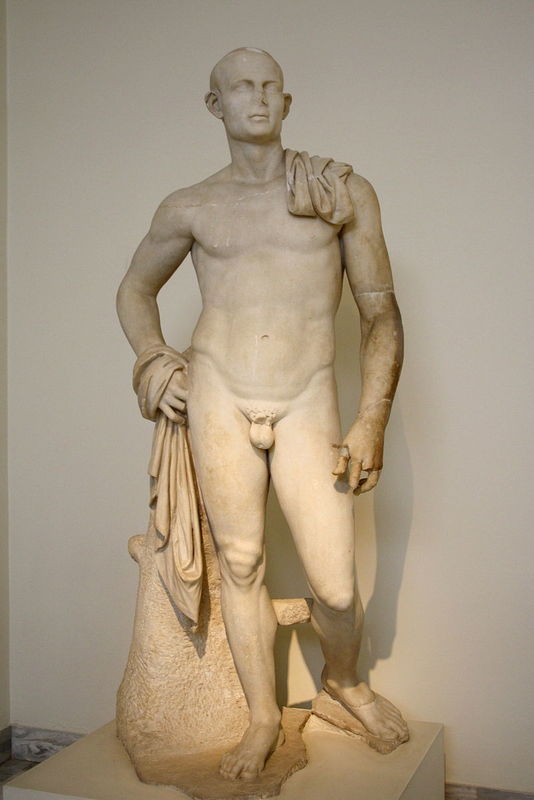Delos Pseudo-Athlete
Title
Date
Artist or Workshop
Materials
Height of the work
Provenience
Current Location
Sitter Biography
Description and Significance
The Delos Pseudo-Athlete is standing, naked, next to a conical marble support, with spurs connecting to the calves of the Pseudo-Athlete. He is engaged in a contrapposto pose mimicking the Doryphoros: his right leg is slightly forward, standing erect, while his left foot is placed just behind his body, with his heel lifting gently off of the ground. Thus, he has most of his weight shifted onto his right side, which also makes his shoulders slope downward from left to right. His right foot points directly at the viewer, while his left foot is angled farther to the left. He has slightly protruding and sharply-defined kneecaps above his toned calves, and below his slightly thicker thighs. His left leg is bent as part of the contrapposto pose, such that his left thigh extends just beyond his torso, while his lower leg is bent behind him. At his right hip, his hand is wrapped by a long cloth, which rests both on the marble support next to his right leg, and is also gently draped upon his left shoulder. The youthful virility of the Pseudo-Athlete is best exemplified by his torso: he has a visible "Adonis belt" near his waist, toned abdominal muscles, and pronounced collarbones and pectoral muscles. His right arm is bent such that his hand rests next to his hip, while his left arm, only slightly bent, rests at his side. In stark contrast to this young, muscular body, however, the Pseudo-Athlete has the head of an older man. He is looking slightly up and to the left, with a slightly heroic countenance. His chin-line is masked by a small bag of skin sagging on each side of his chin, his ears protrude slightly away from his head, and below his chin, he has a protruding Adam's apple and a wrinkly, long neck. His face generally does not betray much emotion: his lips show no sign of movement, and his gaze seems to be rather expressionless. Above his thick eyebrows and deep-set eyes, he has a wrinkled forehead, which gives way to his receding hairline and balding hairstyle. The statue has some damage: a portion of his nose and parts of the fingers on his left hand are now missing.
Significance:
The Delos Pseudo-Athlete is a prime example of cultural syncretism at a time of shifting cultural dominance in the Mediterranean. The statue was found next to a copy of the Diadoumenos, originally created by Polykleitos, which is a statue of a young, athletic man, with a body type nearly identical to that of the Pseudo-Athlete. The "verism" of the statue's head, juxtaposed with the youthful body of the statue, are both characteristics of Roman portrait statues, while the heroic nudity of the statue is a Greek ideal. Similarly, the head of the statue tilting left and upward evokes Alexandrian and Hellenistic sculpture. Roman portrait statues of the Late Republican period are labelled with the modern term "veristic," or "truthful," which is used to describe the perceived realism of the portraits' faces; at times, however, these representations may over-exaggerate the facial imperfections of the sitter. Verism may have gained wide use in Rome via Hellenistic representations of philosophers and politicians, through the tradition of Roman ancestor masks, or, as Charles Brian Rose claims, as a way from Romans to differentiate their portraiture from the portraits of the people they conquered in this time period. Verism also became an avenue through which the sitter could promote their station in the Roman political track, or the cursus honorum. In the Republic, the ideal Senator would progress through a sequence of political offices, and thus, his age would connote his political experience and dedication to the Roman state. The apparent mismatch between the old age of the head and the youthful strength of his body is a testament to the Roman idea of the head as a locus for individuality; many Roman copies of Greek bronze statues, for example, are simply heads or herms. Squire claims that this formulaic body type and the Roman process of extracting heads from statues are related processes that indicate the Roman belief that the head was the most individualizing feature of the human body.
References
Squire, Michael. Roman Portraiture and the Semantics of Extraction. Face and Identity, Wilhelm Fink, 2014. pp. 90-97.
http://dcl.elevator.umn.edu/asset/viewAsset/56ddd1927d58ae56388b7048#56ddd1927d58ae56388b704f
Contributor
Citation
Item Relations
This item has no relations.

